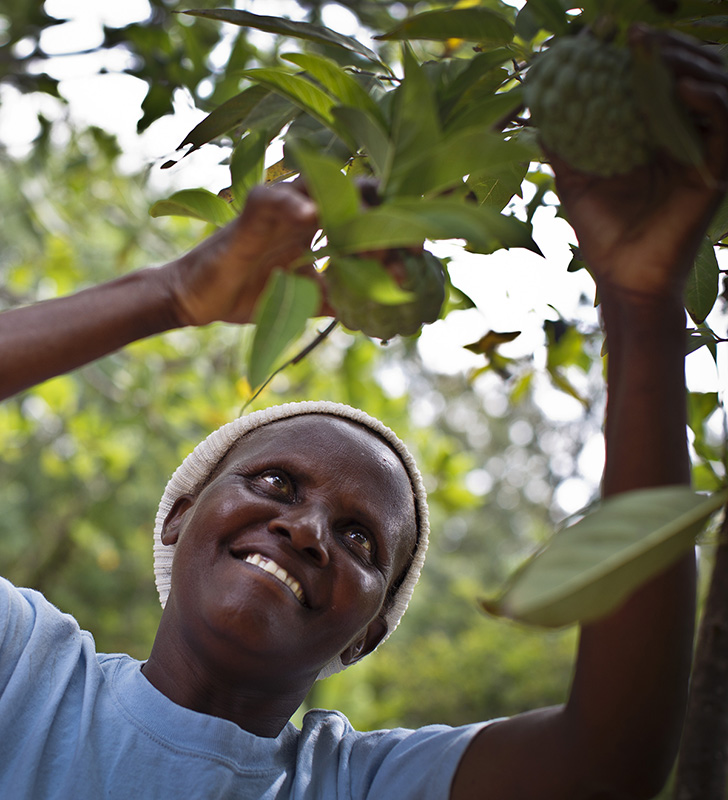Ugandan farmers are now able to access a bundle of information that is critical to their businesses. Packaged as satellite data related to weather alerts, crop management information and financial services, the complete set of information products enables farmers and their agents to interpret and navigate the system from the palm of their hands.
The Market-led, User-owned ICT4Ag-enabled Information Service (MUIIS) is an innovative project across 54 farmer institutions that directly empowers 350,000 farmers to increase their productivity of maize, soybean, beans and sesame. It addresses the current lack of information services among Ugandan farmers and them to make informed decisions regarding the use of agricultural inputs, such as improved seeds, fertilisers, herbicides and pesticides. Armed with this information, farmers can improve their yields and protect their crops against pests and disease, as well as increase their resilience to flooding and drought.
Commenting on the services, the Minister of State for Agriculture, Christopher Kibazanga, said to avoid duplication of services, government planned to work with registered farmers on the platform to offer extensions services. “We have recruited 300 extension workers, and a further 2000 will raise the total to 5000 to work with farmers,” he explained.
On the other hand, Dick Nuwamanya, president of the Uganda National Farmers Federation (UNFFE) has commended the project for empowering farmers with timely information amidst climate change, enabling them to better plan for crops and livestock feeds.
MUIIS is credited with increasing farmer engagement with ICTs for agricultural development, improving the sustainability of food production and farmers’ resilience to the impacts of climate change. The project’s consortium, leverages on its farmer networks to effectively reach a large number of smallholders.
The indirect beneficiaries of the project include traders and marketers including input and output dealers, extension service providers, software development companies and research institutions. This gives credence to the reality that the success of agriculture, a predominantly private sector activity, is hinged to the investments and enabling policies of national government institutions combined with the vigor of the private sector to implement and multiply the benefits to accelerate agricultural growth in Africa.
The project is implemented by a partnership of AGRA, the Technical Centre for Agricultural and Rural Cooperation (CTA) in collaboration with the Earth Environment Monitoring (EARS) bv, eLEAF bv, Mercy Corps, Uganda Cooperative Alliance (UCA), UNFFE, the National Agricultural Research Organisation (NARO), Agricultural Insurance Consortium (AIC) and Ensibuuko Technologies.
***
One farmer’s story
Sabiiti Erick is one of the beneficiary farmers in Bbulabakulu, Nambi Parish, Zirobwe Sub County in Luwero District. He grows maize and beans for food and for the market on eight acres, dividing the farm to accommodate four acres each of maize and beans. He sometimes plants sweet potatoes and vegetables on the same pieces of land after harvesting the main crop.
Sabiiti has been farming as a business for the last ten years. Before venturing into large scale production of maize and beans he used to utilize only one acre for subsistence. Depending on the weather, quality of seeds and agro-chemicals, pests and disease he would harvest about 1500 kilograms or less of maize.
“But I was finding it hard to pay school fees for my children using proceeds from the farm at the time. This pushed me to want to improve and increase my farming activities to overcome the money shortage.
How did Sabiiti make the decision to increase his earnings?
Without another source of income to sustain the family, Sabiiti accompanied his friend to the Zirobwe Agali Awamu Farmers Association (ZAABTA) Training Center to listen and learn for himself what his colleagues had been telling him.
At the training center, farmers were given tips on best farming practices for increased yields and income. The tips included timely land preparation and planting and insisting on using quality agro-inputs, among others.
“Back on the farm, I put into practice what I had learned at the training center,” he says. “That first season, I planted two acres of beans and maize, the yield was better than I had ever imagined. I continued with the training and mastered most of the things.” It was at this point that he gained the courage to plant all the eight acres.
From one acre of maize, Sabiiti was able to harvest 2500 kilograms, up from the previous 1500 kilograms. Today his maize yield has almost doubled to 3200 kilograms per acre per season. He attributes the increase in production to the good agronomical practices he employs.
Before the training, he said he had not been too concerned about the proper handling of the harvested food. When it came to storage, Sabiiti recalls how he and his family would simply store the maize or beans in one of the rooms in his house, partitioned from the kitchen to act as a store. However, since the room was not properly finished, it wasn’t long before the grains were attacked by rats and insects, occasioning him great losses.
Now he knows better and handles his harvest with care. It meant constructing a separate room for a store and cementing the floors and walls. In addition to investing in tarpaulins for drying the grain, Sabiiti then bought some raised pieces of wood, on which he placed the maize in bags to avoid direct contact with the floor,
Where does he sell the maize?
Knowing that access to markets remains a challenge for farmers, Sabiiti has established a cordial relationship with the headteachers in his children’s schools and they have engaged him on contract to supply them with maize.
“If we harvest more maize in our area, prices tend to be low, but if production is less, the prices rise.” he observes.
His total bill for school fees is Ush 1.4 million (US $375). To overcome cashflow difficulties in between sales, when payments are due at school, the outstanding school fees are deducted before Sabiiti is handed the balance from the sale of maize. In the previous school term, Sabiiti offset his bill of Ush 1.05 (US $282) million through his maize sales.
“I am relieved that I don’t owe the school money,” he adds, “I use the balance on the payments in my coffee farm and to prepare the farm for the next planting season.”
Other than market instability, other challenges affecting farmers like Sabiiti include price fluctuations, unreliable weather and especially prolonged droughts, pests and disease among others.
How has drought affected Sabiiti?
Sabiiti recalls that in the 2017 planting season farmers were badly affected by drought. From the four acres of maize, he only harvested 1500 kilograms instead of the anticipated 3000 kilograms. However, there was some relief after he enrolled for drought insurance through the MUIIS Service Bundle to prevent future losses.
Recently, when he lost some of the harvest on an acre of land to drought, he received Ush 19,000 (US $5) as compensation for the losses he incurred. He used the money to buy one liter of herbicides to clear land for the next planting season.
How did Sabiiti learn about the MUIIS Service Bundle?
“I learnt of the service bundle through the chairperson of Bulabakubo Farmers Group. In one of the weekly meetings, he introduced us to the concept with the help of MUIIS Service Agents (MSA) who were working with ZABTA,” says Sabiiti.
At first the farmers doubted their chairperson and told him as much. “We were convinced that this as a ploy to steal our money or worse, identify people with more land that they could take from us under the pretext that they are helping farmers,” Sabiiti adds.
After an explanation from the agents and the head of ZABTA, farmers accepted f and were registered. During registration, they were to register one acre to which we would plant either beans or maize which he insured for Ush 20, 000 (US $5.4). A total of 804 farmers registered for MUISS Service Bundle in Zirobwe.
In 2017, when Sabiiti enrolled for the MUIIS Service Bundle he started receiving farming advice and tips through his mobile phone on weather updates, and received information on when to plant, disease and pest management information, and advice on what to look out for in the farm, among others. Sabiiti registered a minimal loss that season,
Why did other farmers opt out of the arrangement?
Unlike Sabiiti who is a happy farmer, others are not, because they say they expected more than drought insurance. Aisha Nakyanzi from Zirobwe also enrolled for the service but dropped out along the way. Her reasons range from the small amounts of money paid out in compensation, compared to the scale of the famer’s loss and limited services on the service bundle.
Most of the farmers had rented land, incurring additional costs, yet the insurance package only catered for drought-related loss. For example, Nakyanzi registered her one-acre land, but the maize was affected by floods, unfortunately the service bundle couldn’t assist her because the package was only for drought.
“We expected that the insurance would cover all risks including floods, but when I lost my crop to floods, I was told to enroll for a separate flood cover package worth Ush 20,000 (US $5.4) and I found it too expensive,” says Nakyanzi.





